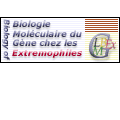
|
|















|
International Summer School
From Genome to Life:
Structural, Functional and Evolutionary approaches
|
ARMENGAUD
Jean |
|
CEA-Valrho, DSV-DIEP-SBTN, BP 17171, Bagnols Sur Cèze 30207, France title: Structural and biochemical systematics of unknown proteins from Archaea conserved in Eucarya Jean Armengaud, Valérie Chaumont, Bernard Fernandez, Claude Vidaud (CEA-Valrho, DSV-DIEP-SBTN, Marcoule, France) ; Laurence Blanchard, Pierre Gans (IBS-LRMN, Grenoble, France) ; Samuel Theze, Dominique Housset, Juan Fontecilla (IBS-LCCP, Grenoble, France) ; Hannu Myllykallio, Yvan Zivanovic, Patrick Forterre (Université Paris XIII, Orsay, France). Genomic sequencing is revealing huge numbers of polypeptides whose function is unknown. Structural genomics projects may help for identifying the biochemical roles of these new proteins. Using comparative genomics, a group of proteins from Archaea without assigned function but conserved in Eukarya (PACEs) were identified (Matte-Taillez et al., 2000). A project aimed at solving the structure of this group of conserved proteins is carried out, along with the characterization of their biochemical properties and possible functions. We first focus our efforts on a set of nine targets, half of them amenable to RMN characterization on the basis of their relative small size. The genes were amplified from genomic DNA of Pyrococcus abyssi or Sulfolobus solfataricus and cloned into pCRT7-topo vector. The resulting HIS-tagged constructs were introduced into Escherichia coli strains modified by the addition of rare tRNA genes. The expression of Archaea genes that contain codons rarely used in bacteria was greatly enhanced, resulting for some constructs in high production of the polypeptide (1-5 % of total cell proteins). A simple three-step purification protocol was developped to purify to homogeneity the first two proteins, PAB0944 (PACE11) and PAB0955 (PACE12). Heat denaturation of E. coli proteins, followed by IMAC chromatography resulted in separation of the proteins from the major contaminants. A higher degree of purity was obtained by ion-exchange chromatography. The yield for the two purified proteins was 20 and 5 mg/L of culture, respectively. The biochemical and structural characterization of these proteins is currently carried out and the first data should give some new clues about their function.
|
|
ADDITIONAL DATA |
|
|